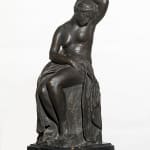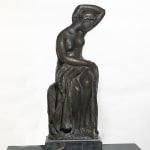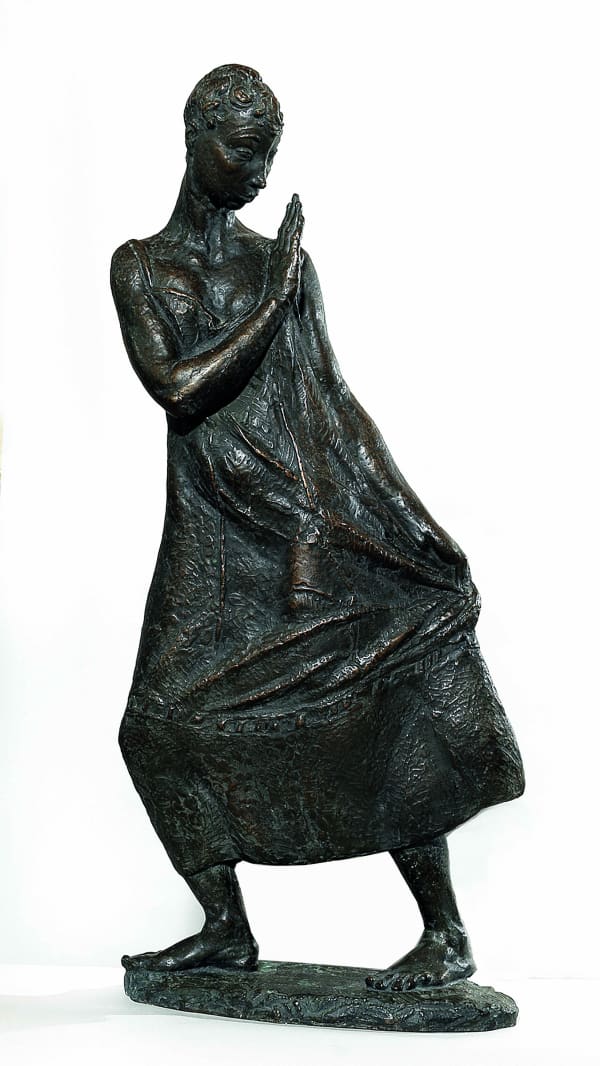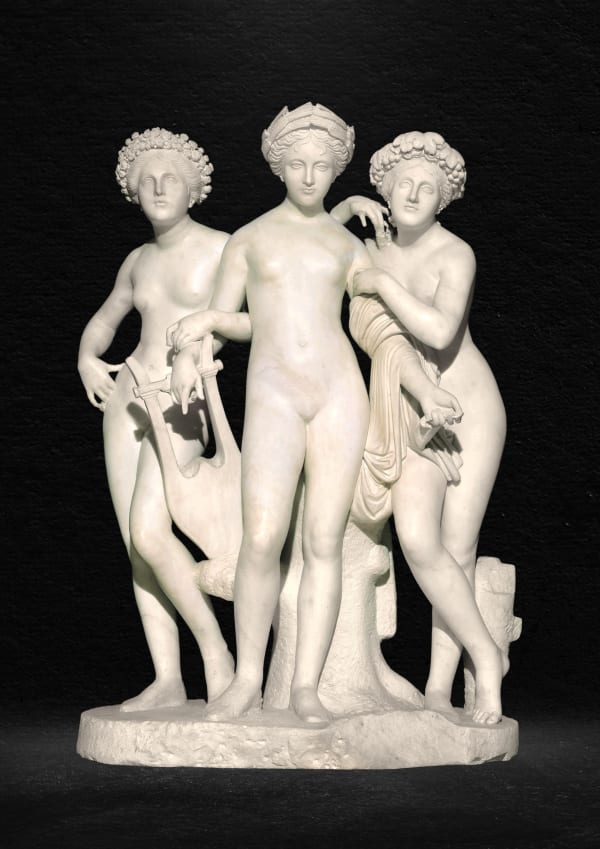

LIBERO ANDREOTTI ROME, 1875-1933
Provenance
Florence, private collection
The bronze Veneretta, or Small Venus, under discussion in this paper, a nude female figure seated on a plinth which acts as the base for the sculpture itself, partly covered by a sheet held in place on her legs by her right hand, her left arm raised, is in every sense a previously unpublished work[1].
To date, only two plaster versions, 48 cm. high, were known of this subject, one of them with the figure totally naked and the other in which she is clad in a sheet on which we can see the points used for translating the statue to scale (Gipsoteca Libero Andreotti, Pescia);[2] and one larger marble version (h. 91 cm.), signed and dated 1910–1920 (private collection, formerly in the collection of Andreotti's heirs in Florence). Also, a Veneretta very similar to those just described may be seen in a photograph of Andreotti's Paris atelier in which he is shown working on a clay model of the sculpture resting on a revolving stand. In this version, she holds a sheet above her head with her left arm, the sheet tumbling down her side (the sheet over the legs is absent) as she sits on a storied plinth with a figure in bas-relief[3].
The exemplar under consideration here is inscribed, as in the case of the plaster version, with author’s partially readable name [...]ndreo[...] and the date 1912 on the back of the plinth, and signed and dated “S[partaco] L[ibero] Andreotti 1916” in another part of the plinth itself. Its appearance on the market suggests a hypothesis explaining the succession of phases involved in the production of the various versions of the same subject in plaster, in marble and in bronze as here. Thus it is plausible that the initial idea devised by the sculptor for the Veneretta is the one recorded in the photograph of his Paris atelier: a figure of a nude young woman with a sheet held in her raised left hand. Where positing a date for the bronze is concerned, the terminus ante quem is given by the presence in the photograph of the clay model for the left-hand panel of the Frise nuptiale,[4] a plaster triptych that caused something of a stir when Andreotti showed it at the Salon della Société Nazionale des Beaux-Arts in April 1912. The fact that the Frise is shown still unfinished tells us that the Veneretta must have been made prior to April 1912, thus most probably in 1910 or 1911.
If we compare the two plaster works in Pescia with the clay model in the photograph, we can see how the left arm, which in the photograph appears raised to hold the sheet, is now lowered and folded over the Veneretta's head. The two plaster works, totally identical apart from the absence of the sheet on the legs in one of them, point to second thoughts on the sculptor's part regarding the pose of the figure as recorded in the Paris photograph. He initially eliminated the presence of the sheet and intervened on the modelling of the plinth with rapid thumb marks, as we can see from the plaster version inv. no. AFCP: 71, g. 60; then he subsequently provided the sculpture with a new sheet, resting it on the figure's legs but without making any further changes to the composition, as we can see in the plaster version inv. no. AFCP: 72, g. 60 bis. This latter version served as the model both for the bronze cast under discussion here, produced in 1916 as we can tell from the date on the back of the plinth, thus after the sculptor's return to Italy; and, in view of the presence of the points, for translation into a larger marble version. This explains also the dual date 1910–1920 on the back of the plinth in the marble version of the Veneretta, a work whose conception and modelling date back to Andreotti's first stay in Paris, in 1910, but which was subsequently resumed and carved in marble in Tuscany in 1920, when the influence of the old masters was at a peak for the sculptor after his time in Milan and in Paris.
On leaving Milan and the 'total Divisionism' project devised by dealer Alberto Grubicy on the grounds that it no longer coincided with his new stylistic aspirations, which were directed towards a broader and more simplified form of sculpture, Andreotti took up residence in the French capital in October 1909. The city, so frenzied as to make his head spin, had already flattered him by offering him a certain renown when he first showed his work there, still in Grubicy's company, in 1907 and '08. Gabriel Mourey and Vittorio Pica had shown interest in his work on those two occasions, nor was his stay in Paris going to deprive the young artist of their ongoing critical support. Moreover, his repertoire of sophisticated, sleek greyhound-like ladies, part fragile and part bizarre, met the aesthetic taste of a man whom he had met in Milan, the great couturier of the Rue de la Paix, a collector and patron of the arts and artists called Jean-Philippe Worth, who invited him to leave Milan with the tempting prospect of introducing him into the French capital's most exclusive society circles. In that climate, made of daring and of unbridled artistic endeavour, the stimuli that Paris offered Andreotti were as different as they were numerous. The tired symbolism of the fin de siècle dandies, the passionate style of Rodin, the new and tempered sensuality of Maillol and the heroic vitality of Bourdelle coexisted alongside the revolutionary sculptural experiments and abstractions of Archipenko, Zadkine and Brancusi.
A few months after his arrival, Andreotti already seemed to be very much at home in this new world, winning much praise with his Miracle at the Salon de la Société Nationale des Beaux-Arts in April 1911. Shortly afterwards, in the second half of April 1911, he held a one-man show of his work at the Galerie Bernheim-Jeune, an exhibition widely reviewed in the press that enabled Andreotti to confirm his earlier promise in full. After 1911, his name began to be mentioned not only in reports of exhibitions at which he was showing his work but also in reports of the countless events that filled the social life of the French capital in its salons, its theatres and its cafés. Andreotti appears to have been attracted primarily by the female figure – and this, from his earliest youth in Tuscany, in view of his initial production of graceful and provocative latter-day Tanagra-like figurines – which he began to model as soon as he arrived in Paris. In his early days in the capital he produced women d'aujourd'hui, captured in their daily activities, dressed in fashionable clothing, their bodies revealing bold and slender figures, amazons moving with the agility and grace of Diana in the ancient world, Magdalens who, in the cloaks that swathe them, bend to pain by holding out their arms, young girls evoking the freshness of adolescence, or mothers bearing the weight and responsibility of a child on their shoulders. It is worth quoting a memory of Enrico Sacchetti, who travelled to Paris to meet his friend Andreotti in 1911, describing The Girl Diving,[5] a figure whose resemblance to the Veneretta is so glaring in her elongated eyes and in the way her hair is plaited as to suggest that the sculptor may well have used the same model for both:
“What struck me at once and surprised me in a positive sense was the chastity of the figures, a premeditated chastity deliberately opposed to the sensuality so common in all of his other works. But also the confident stability, the correct weight – the weight of a living body – the extremely well thought-out counterpoint of the volumes and the clear decision to forgo any kind of extra-sculptural artifice, all of these were new to my friend's art”.[6]
And it is true that after the exhibition at the Galerie Bernheime-Jeune in 1911, Andreotti's sculptural style began to change. In the works that he produced in 1912 and '13, the astonishing Dancers with Cymbals, with the Mask of Medusa and with Bunches of Grapes, he achieves a calm solidity in which the swell of the surfaces, the archaic synthesis of the faces with their enigmatic smiles and the balance between expression and style are all reminiscent of the Classical and Archaic inspiration of French sculpture in those years, particularly that of Maillol and of Joseph Bernard.
[1] This bronze version does not appear in the printed material devoted to the Tuscan sculptor either while he was alive or afterwards, nor is it mentioned in the private and autograph documentation in the Archivio Andreotti in the Biblioteca Comunale di Pescia, or in the inventory drafted by the artist's wife Margherita Carpi after his death and now owned by his heirs in Florence.
[2] inv. AFCP: 71, g.60; inv. AFCP: 72, g. 60 bis, cf. Gipsoteca Libero Andreotti Pescia, ed. Ornella Casazza, Florence, Grafiche il Fiorino,1992, pp. 92-93 (illustrated, erroneously dated 1919–20).
[3] This photograph too, like the marble version of the Veneretta, from the archives of the sculptor's heirs in Florence, is now in a private collection.
[4] The Frise nuptiale is now in the Gipsoteca Libero Andreotti in Pescia (inv. AFCP: 7°, g. 119; 7b, g. 119b; 7c, g. 119c), Gipsoteca Libero Andreotti Pescia, op. cit, pp. 107-110 (illustrated).
[5] Also known as Fontana, the plastercast is now in the Gipsoteca Andreotti in Pescia (inv: AFCP: 21, g. 8), cf. Gipsoteca Libero Andreotti Pescia, op. cit, pp. 94-95 (illustrated).
[6] E. Sacchetti, Vita d’artista, Milan, Treves, 1935, p. 123.






